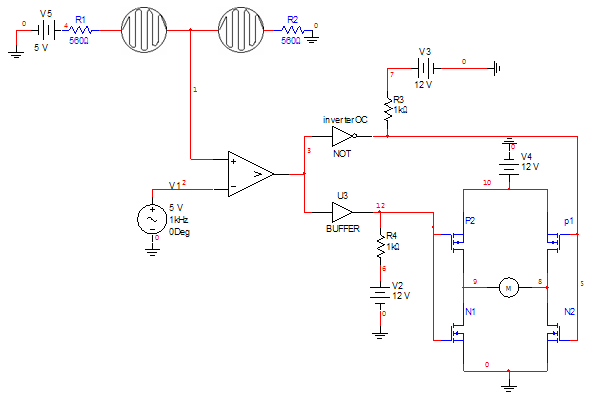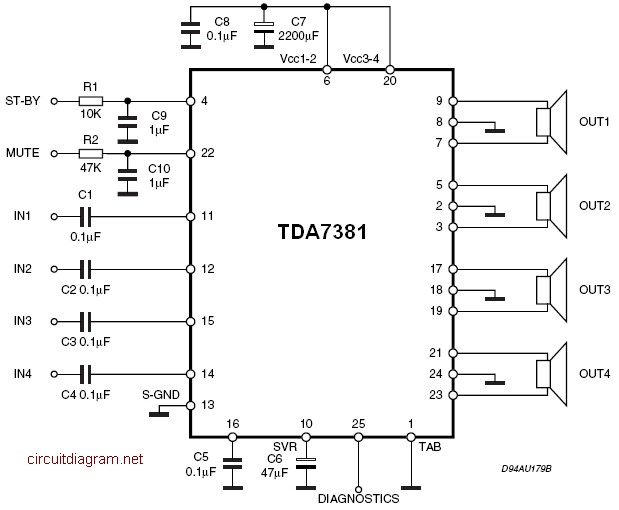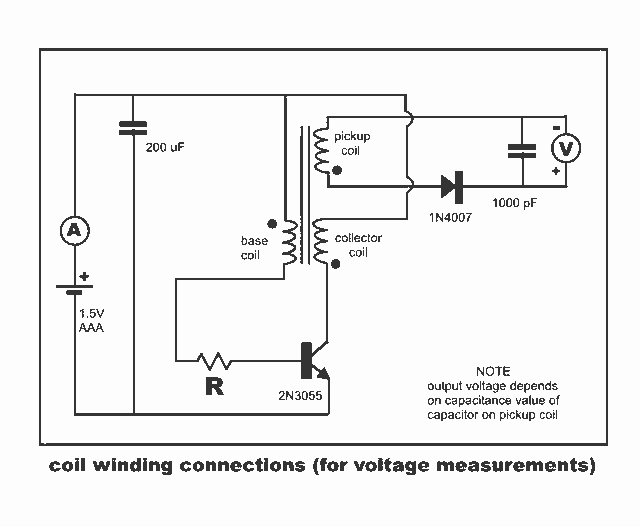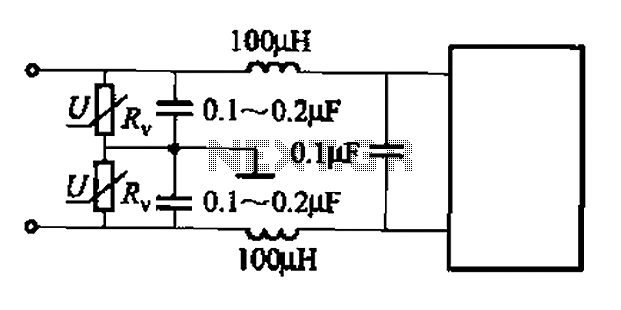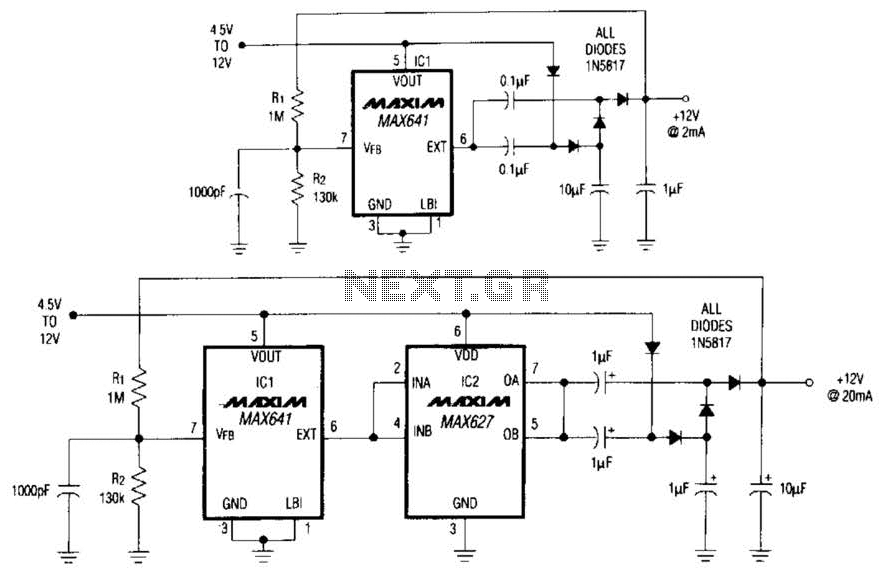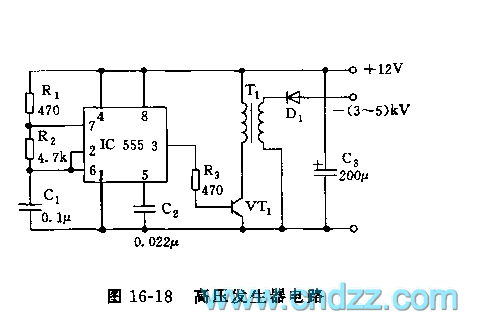
Synchronous Stepdown Switching Regulator Circuit
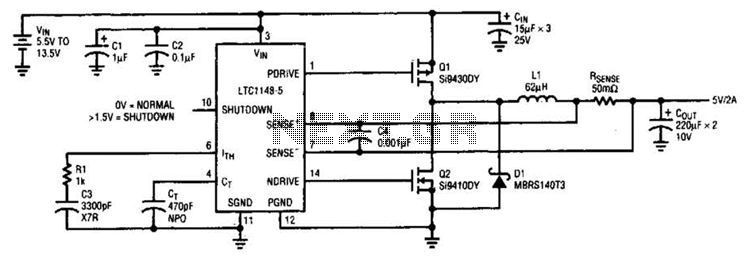
A typical LTC 1148 surface-mount application provides 5 V at 2 A from an input voltage range of 5.5 V to 13.5 V. The operating efficiency, illustrated in B, peaks at 97% and remains above 90% from 10 mA to 2 A with a 10-V input. Q1 and Q2 serve as the main switch and synchronous switch, respectively, while inductor current is monitored through the voltage drop across the current shunt. The component /vgENSE is crucial for setting the output current capability according to the formula QOUT = 100 mV/ftSENSE.
The benefits of current control include superior line and load transient rejection, built-in short-circuit protection, and regulated startup currents. The peak inductor current is limited to 150 mV/SENSE or 3 A for the circuit described in A.
The LTC 1148 is a high-efficiency DC-DC converter designed for surface-mount applications. It is capable of delivering a regulated output voltage of 5 V at a maximum load current of 2 A, making it suitable for various electronic devices requiring stable power supply. The input voltage range of 5.5 V to 13.5 V allows for flexibility in power source selection, accommodating a wide array of applications.
The efficiency of the LTC 1148 is a critical parameter, with a peak performance of 97% and maintaining over 90% efficiency across a load range from 10 mA to 2 A when supplied with a 10 V input. This efficiency is essential for minimizing heat generation and maximizing battery life in portable applications.
The circuit employs two key components: Q1, the main switch, and Q2, the synchronous switch. These transistors work in tandem to regulate the output voltage by rapidly switching on and off in response to the load conditions. The inductor current is monitored through a current shunt, which provides a voltage drop proportional to the current flowing through it. This measurement is critical for feedback control, ensuring that the output voltage remains stable under varying load conditions.
The /vgENSE component plays a vital role in defining the output current capability. The formula QOUT = 100 mV/ftSENSE indicates that the output current can be accurately set by adjusting the voltage across the sense resistor, allowing for precise control over the power delivered to the load.
Incorporating current control into the design offers significant advantages, including excellent transient response to sudden changes in load or input voltage, which is critical for maintaining stable operation in dynamic environments. Additionally, the built-in short-circuit protection enhances the reliability of the device, preventing damage during fault conditions. Controlled startup currents further contribute to the safety and longevity of the circuit by mitigating inrush current effects that could adversely affect other components in the system.
The circuit limits peak inductor current to 150 mV/SENSE, translating to a maximum of 3 A, which protects the converter from excessive current that could lead to overheating or failure. This design consideration is crucial for maintaining the integrity and performance of the LTC 1148 in various applications. A shows a typical LTC 1148 surface-mount, application providing 5 V at 2 A from an input voltage of 5.5 V to 13.5 V. The operating efficiency, shown in B, peaks at 97% and exceeds 90% from 10 mA to 2 A with a 10-V input.
Ql and Q2 comprise the main switch and synchronous switch, respectively, and inductor current is measured via the voltage drop across the current shunt. /vgENSE is the key component used to set the output, current capability according to the formula/QUT =100 mV/ftSENSE.
The advantages of current control include excellent line and load transient rejection, inherent short-circuit protection and controlled startup currents. Peak inductor current is limited to 150 mV//SENSE or 3 A for the circuit in A. 🔗 External reference
The benefits of current control include superior line and load transient rejection, built-in short-circuit protection, and regulated startup currents. The peak inductor current is limited to 150 mV/SENSE or 3 A for the circuit described in A.
The LTC 1148 is a high-efficiency DC-DC converter designed for surface-mount applications. It is capable of delivering a regulated output voltage of 5 V at a maximum load current of 2 A, making it suitable for various electronic devices requiring stable power supply. The input voltage range of 5.5 V to 13.5 V allows for flexibility in power source selection, accommodating a wide array of applications.
The efficiency of the LTC 1148 is a critical parameter, with a peak performance of 97% and maintaining over 90% efficiency across a load range from 10 mA to 2 A when supplied with a 10 V input. This efficiency is essential for minimizing heat generation and maximizing battery life in portable applications.
The circuit employs two key components: Q1, the main switch, and Q2, the synchronous switch. These transistors work in tandem to regulate the output voltage by rapidly switching on and off in response to the load conditions. The inductor current is monitored through a current shunt, which provides a voltage drop proportional to the current flowing through it. This measurement is critical for feedback control, ensuring that the output voltage remains stable under varying load conditions.
The /vgENSE component plays a vital role in defining the output current capability. The formula QOUT = 100 mV/ftSENSE indicates that the output current can be accurately set by adjusting the voltage across the sense resistor, allowing for precise control over the power delivered to the load.
Incorporating current control into the design offers significant advantages, including excellent transient response to sudden changes in load or input voltage, which is critical for maintaining stable operation in dynamic environments. Additionally, the built-in short-circuit protection enhances the reliability of the device, preventing damage during fault conditions. Controlled startup currents further contribute to the safety and longevity of the circuit by mitigating inrush current effects that could adversely affect other components in the system.
The circuit limits peak inductor current to 150 mV/SENSE, translating to a maximum of 3 A, which protects the converter from excessive current that could lead to overheating or failure. This design consideration is crucial for maintaining the integrity and performance of the LTC 1148 in various applications. A shows a typical LTC 1148 surface-mount, application providing 5 V at 2 A from an input voltage of 5.5 V to 13.5 V. The operating efficiency, shown in B, peaks at 97% and exceeds 90% from 10 mA to 2 A with a 10-V input.
Ql and Q2 comprise the main switch and synchronous switch, respectively, and inductor current is measured via the voltage drop across the current shunt. /vgENSE is the key component used to set the output, current capability according to the formula/QUT =100 mV/ftSENSE.
The advantages of current control include excellent line and load transient rejection, inherent short-circuit protection and controlled startup currents. Peak inductor current is limited to 150 mV//SENSE or 3 A for the circuit in A. 🔗 External reference
